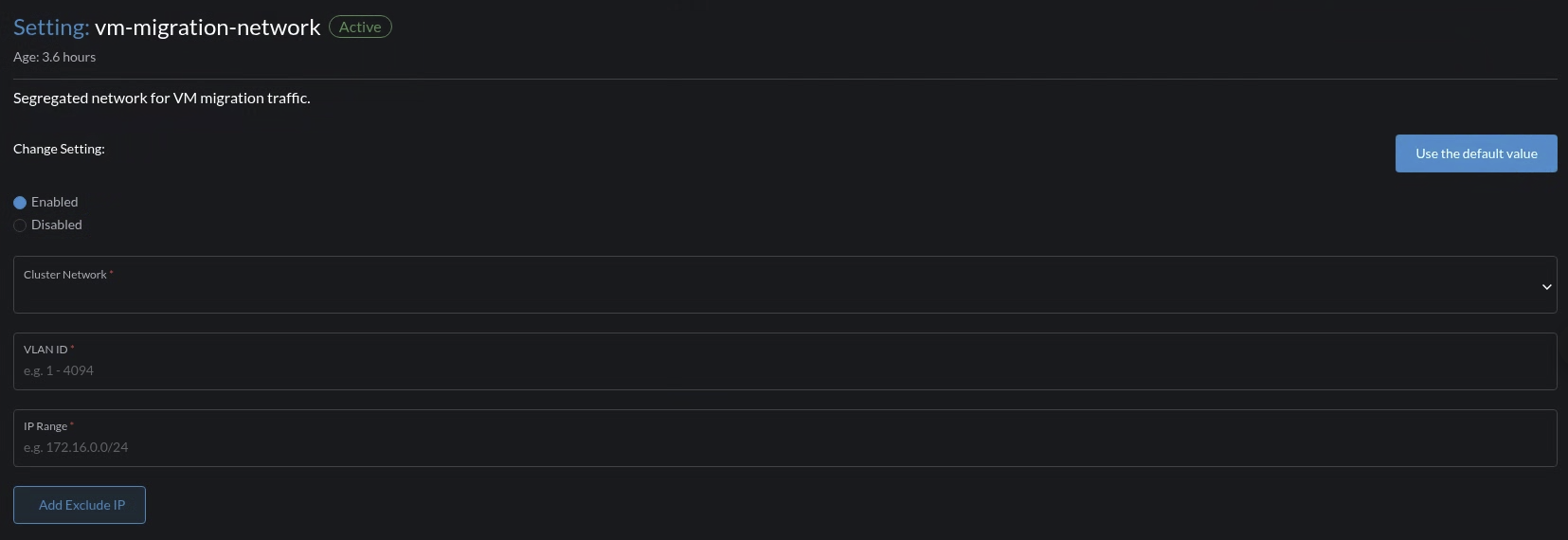VM Migration Network
A VM migration network is useful for isolating migration traffic from cluster traffic on mgmt and other cluster-wide workloads. Using a VM migration network results in better network bandwidth and performance.
Avoid configuring KubeVirt settings directly, as this can result in unexpected or unwanted system behavior.
Prerequisites
Before you begin configuring the VM migration network, ensure that the following requirements are met:
The network switches are correctly configured, and a dedicated VLAN ID is assigned to the VM migration network.
The cluster network and VLAN network are configured correctly. Ensure that both networks cover all nodes and are accessible.
No virtual machines are being migrated.
The IP range of the VM migration network is in the IPv4 CIDR format and must neither conflict nor overlap with Kubernetes cluster networks. The following addresses are reserved:
10.42.0.0/16,10.43.0.0/16,10.52.0.0/16and10.53.0.0/16.
vm-migration-network Setting
The vm-migration-network setting allows you to configure the network used to isolate in-cluster VM migration traffic when segregation is required.
You can enable and disable the VM migration network using either the UI or the CLI. When the setting is enabled, you must construct a Multus NetworkAttachmentDefinition CRD by configuring certain fields.
- UI
- CLI
Using the Harvester UI to configure the vm-migration-network setting is strongly recommended.
Enable the VM Migration Network
Go to Advanced > Settings > vm-migration-network.
Select Enabled.
Configure the VLAN ID, Cluster Network, IP Range, and Exclude fields to construct a Multus
NetworkAttachmentDefinitionCRD.Click Save.

Disable the VM Migration Network
Go to Advanced > Settings > vm-migration-network.
Select Disabled.
Click Save.
Once the VM migration network is disabled, KubeVirt starts using mgmt for VM migration-related operations.

You can use the following command to configure the vm-migration-network setting.
kubectl edit settings.harvesterhci.io vm-migration-network
The VM migration network is automatically enabled when the value field contains a valid JSON string.
Example:
apiVersion: harvesterhci.io/v1beta1
kind: Setting
metadata:
name: vm-migration-network
value: '{"vlan":100,"clusterNetwork":"vm-migration","range":"192.168.1.0/24", "exclude":["192.168.1.100/32"]}'
The VM migration network is disabled when you remove the value field or set it to an empty string.
apiVersion: harvesterhci.io/v1beta1
kind: Setting
metadata:
name: vm-migration-network
apiVersion: harvesterhci.io/v1beta1
kind: Setting
metadata:
name: vm-migration-network
value: ''
Harvester considers extra insignificant characters in a JSON string as a different configuration.
The following occur once the vm-migration-network setting is applied:
- Harvester creates a new
NetworkAttachmentDefinitionand updates the KubeVirt configuration. - KubeVirt restarts all
virt-handlerpods to apply the new network configuration.
Post-Configuration Steps
Verify that the setting's status is
Trueand the type isconfiguredusing the following command:kubectl get settings.harvesterhci.io vm-migration-network -o yamlExample:
apiVersion: harvesterhci.io/v1beta1
kind: Setting
metadata:
annotations:
vm-migration-network.settings.harvesterhci.io/hash: ec8322fb6b741f94739cbb904fc73c3fda864d6d
vm-migration-network.settings.harvesterhci.io/net-attach-def: harvester-system/vm-migration-network-6flk7
creationTimestamp: "2025-06-13T06:36:39Z"
generation: 51
name: vm-migration--network
resourceVersion: "154638"
uid: 2233ad63-ee52-45f6-a79c-147e48fc88db
status:
conditions:
- lastUpdateTime: "2025-06-13T13:05:17Z"
reason: Completed
status: "True"
type: configuredVerify that all KubeVirt
virt-handlerpods are ready and that their networks are correctly configured.You can inspect pod details using the following command:
kubectl -n harvester-system describe pod <pod-name>Check the
k8s.v1.cni.cncf.io/network-statusannotations and verify that an interface namedmigration0exists. The IP address of this interface must be within the designated IP range.You can retrieve a list of
virt-handlerpods using the following command:kubectl get pods -n harvester-system -l kubevirt.io=virt-handler -o yamlExample:
apiVersion: v1
kind: Pod
metadata:
annotations:
cni.projectcalico.org/containerID: 004522bc8468ea707038b43813cce2fba144f0e97551d2d358808d57caf7b543
cni.projectcalico.org/podIP: 10.52.2.122/32
cni.projectcalico.org/podIPs: 10.52.2.122/32
k8s.v1.cni.cncf.io/network-status: |-
[{
"name": "k8s-pod-network",
"ips": [
"10.52.2.122"
],
"default": true,
"dns": {}
},{
"name": "harvester-system/vm-migration-network-6flk7",
"interface": "migration0",
"ips": [
"10.1.2.1"
],
"mac": "c6:30:6f:02:52:3e",
"dns": {}
}]
k8s.v1.cni.cncf.io/networks: vm-migration-network-6flk7@migration0
Omitted...
Best Practices
When configuring an IP range for the VM migration network, ensure that the allocated IP addresses can service the future needs of the cluster. This is important because KubeVirt pods (
virt-handler) stop running when new nodes are added to the cluster after the VM migration network is configured, and when the required number of IPs exceeds the allocated IPs. Resolving the issue involves reconfiguring the VM migration network with the correct IP range.Configure the VM migration network on a non-
mgmtcluster network to ensure complete separation of the VM migration traffic from the Kubernetes control plane traffic. Usingmgmtis possible but not recommended because of the negative impact (resource and bandwidth contention) on the control plane network performance. Usemgmtonly if your cluster has NIC-related constraints and if you can completely segregate the traffic.